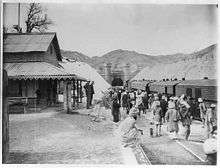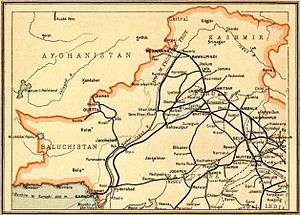History of rail transport in Pakistan
- This article is part of the history of rail transport by country series.
The history of rail transport in Pakistan covers the period beginning in 1855 during the British Raj, when several railway companies began laying track and operating in what is today Pakistan, and ending during the present-day nationalised company under the name of Pakistan Railways (initially known as Pakistan Western Railways). The railway system in Pakistan was originally built as a patchwork of local rail links operated by small private railway companies. These included the Scinde Railway, Punjab Railway, Delhi Railway and Indus Steam Flotilla companies. In 1870, these 4 companies were amalgamated into the Scinde, Punjab & Delhi Railway company. Shortly thereafter, several other railways lines were built including the Indus Valley State Railway, Punjab Northern State Railway, Sind–Sagar Railway, Sind–Pishin State Railway, Trans–Baluchistan Railway and Kandahar State Railway. These 6 companies along with the Scinde, Punjab & Delhi Railway company merged together to form the North Western State Railway in 1880. In 1947, when Pakistan achieved its independence from Great Britain, the North Western Railway renamed Pakistan Western Railways and the railway system underwent reorganisation, some of which proved controversial. From the start of 1948, usage of railways increased and the network became profitable. Declining passenger numbers and financial losses in the late 1980s to early 1990s prompted the closure of many branch lines and small stations. The 1990s saw severe cuts in rail subsidies and mismanagement within the company. Due to falling passenger numbers, rail subsidies from the government are necessary to keep the railways financially viable.
Early development (1857-1870)

Scinde Railway
The Scinde Railway Company was established in 1855, after the possibility of Karachi as a seaport was first noticed in the early 1850s. Sir Henry Edward Frere was appointed Commissioner of Sindh shortly after the fall of Sindh (Battle of Miani). He sought permission from Lord Dalhousie to begin a survey for a seaport. The Scinde Railway Company was first established by deed of settlement in March 1855 and incorporated by the ‘Scinde Railway Act’ of Parliament in July 1855.[1][2] He also initiated the survey for a railway line in 1858. It was proposed that a railway line from Karachi to Kotri, steam navigation up the Indus and Chenab rivers up to Multan and from there another railway to Lahore and beyond be constructed. Work on the railway line commenced in April 1858 and on 13 May 1861, succeeded in connecting Karachi to Kotri. This was the first railway line for public traffic between Karachi and Kotri, a distance of 108 miles (174 km).[3]

Punjab Railway

The Punjab Railway Company was established shortly after the ‘Scinde Railway Act’ of Parliament in July 1855 was passed.[1][2][4] As the Karachi-Kotri line was being constructed, and the Indus Steam Flotilla was being setup to transport passengers to Multan, the Punjab Railway line began being laid from Multan to Lahore and on wards to Amritsar. The line opened in 1861, thus connecting Karachi and Lahore.
Indus Steam Flotilla
The Indus Steam Flotilla was a freight and passenger steamship company operating initially between Karachi and Multan and later on between Kotri and Multan after the completion of the Karachi-Kotri Railway Line, between 1858 to 1870.[5] The Indus Steam Flotilla provided "the navigation of the Indus, &c, by means of steam vessels [sic], between Kotri and Multan, to be worked in connection with the railways." It came to ply the Indus River and Chenab River all the way from Karachi Port in the south to Makhad in the north, via Jhirk and Mithankot. The journey between Karachi and Multan alone used to take up to 40 days. The company had its headquarters at Kotri. Its promoters negotiated the same guaranteed rate of return as the original guaranteed railways. It later merged with the Scinde Railway and Punjab Railway to form the Scinde, Punjab & Delhi Railway company. The Scinde Railway had been formed in 1855 and in 1861 succeeded in connecting Karachi to Kotri, a distance of 108 miles. Once this railway was in place, the steamers of the Indus Flotilla could take cargo from Kotri instead of Karachi, saving themselves about 150 miles of circuitous wending through the Indus River delta. The railway, however, bypassed Jhirk/Jherruk completely, reducing its importance. In 1856 the charter of the Scinde Railway was expanded to include the construction of Punjab Railway to connect Multan to Lahore and Amritsar.
Mergers & expansion (1870-1885)
Scinde, Punjab & Delhi Railway
The Scinde, Punjab, Delhi Railway was formed in 1870 from the incorporation of the Scinde Railway, Indus Steam Flotilla, Punjab Railway and Delhi Railway companies. This was covered by the ‘Scinde Railway Company's Amalgamation Act‘ of 1869.[1] The company inherited from its constituents the unfortunate reputation as being the worst managed of the early private companies. After its purchase in 1885, SP&DR was merged with several other railways to form the North Western State Railway (NWR).
Indus Valley State Railway
The Indus Valley State Railway line in 1869-70 was undertaken by John Brunton, the Chief Resident Engineer of Scinde Railway, assisted by his son William Arthur Brunton. The Empress Bridge, opened in 1878, carried the IVSR over the Sutlej River between Ferozepur (Firozpur) (south of Lahore) and Kasur. The IVSR had reached Sukkur in 1879 and the steam ferry that transported eight wagons at a time across the Indus between Rohri and Sukkur was found to be cumbersome and time-consuming. The opening of the Lansdowne Bridge in 1889 solved this bottleneck and thus Karachi Port was connected to the railway network. With others, the Indus Valley State Railway was merged with the Scinde, Punjab & Delhi Railway in 1886 to form the North Western State Railway.
Punjab Northern State Railway
Sind–Sagar Railway
Sind–Pishin State Railway
Quetta was always considered as an important strategic destination during British Raj. Britain always considered Russians as a threat to its rule in the South Asia that they might advance from Afghanistan into Quetta and thereby threatening its rule.[6] It was the year 1857 when the idea was suggested by William Andrew (Chairman of Scinde, Punjab and Delhi Railway) that the railways to the Bolan Pass would have strategic role in responding to any threat by Russia. During the second Afghan War (1878–80) between Britain and Afghanistan, a new urgency was needed to construct a Railway line up to Quetta in order to get easier access to the frontier. On 18 September 1879, under the orders of Viceroy council, work begun on laying the railway tracks and after four months the first 215 km of line from Ruk to Sibi was completed and become operational in January 1880. Beyond Sibi the terrain was very difficult. After immense difficulties and harsh weather conditions, it was March 1887 when the railway line of over 320 km long finally reached Quetta.[6]
Trans–Baluchistan Railway
The Trans-Balochistan Railway Line runs from Quetta to Taftan and then into Iranian City of Zahidan. It was named as Nushki Extension Railway as its construction started west of Nushki in 1916. This line reached Iranian city of Zahidan on 1922. The length of this track is 732 kilometers with the last 100 kilometer section being inside Iran. Currently there are hardly any traffic movement on this rail track and the frequency of trains reduced only to one-fortnightly between Quetta and Zahidan.[7]
Kandahar State Railway
North Western State Railway (1885-1947)

The North Western State Railway was formed in January 1886 from the merger of the Scinde, Punjab & Delhi Railway, the Indus Valley State Railway, the Punjab Northern State Railway, the eastern section of the Sind–Sagar Railway and the southern section of the Sind–Pishin State Railway, the Trans–Baluchistan Railway and the Kandahar State Railway.[8] The military and strategic concerns for securing the border with Afghanistan were such that, Francis Langford O'Callaghan (who was posted from the State Railways as "engineer-in-chief") was called upon for a number of demanding railway projects, surveys and constructions on the north-west frontier.[9] These were initially military and strategic projects and became part of the NWR network on formation in 1886. The Bolan Pass railway was completed in 1886 and in 1887, the Khwaja Amran Railway Survey included the Khojak Tunnel and the Chaman Extension Railway.[10] The Khojak Tunnel opened in 1891 and the railway reached Chaman on near the Afghan border. By 1905, it was the longest railway under one administration and the strategic railway of the entire north-west frontier.
Post-independence (1947-1974)
At the time of independence, 1,947 route miles (3,133 km) of North Western Railways were transferred to India, leaving 5,048 route miles (8,124 km) to Pakistan. In 1954, the railway line was extended to Mardan and Charsada, and in 1956 the Jacobabad-Kashmore 2 ft 6 in (762 mm) gauge line was converted into broad gauge. The Kot Adu-Kashmore line was constructed between 1969 and 1973 providing an alternative route from Karachi up the country. In 1961, the Pakistani portion of the North Western Railway was renamed Pakistan Railways.
Pakistan Western Railways
Pakistan Eastern Railways
Nationalisation
See also
References
- 1 2 3 H.M. Government “Statute Law Repeals: Nineteenth Report : Draft Statute Law (Repeals) Bill; April 2012"; pages 134-135, paragraphs 3.78-3.83 Retrieved on 2 January 2016
- 1 2 "Money Market and City Intelligence", "The Times", Wednesday, 15 June 1859, #23333, 7a.
- ↑ Grace’s Guide “Scinde Railway” Retrieved on 2 January 2016
- ↑ http://books.google.co.uk/books?id=s5IEAAAAMAAJ&printsec=frontcover
- ↑ "Money Market and City Intelligence", The Times, Wednesday, 15 June 1859, #23333, 7a
- 1 2 Railways of Afghanistan "Railways and the Great Game" access date: 1 February 2012
- ↑ The Trans-Baluchistan Railway by Owais Mughal date: 13-07-2007 access date: 01-03-2012
- ↑ " Administration Report on the Railways in India – corrected up to 31st March 1918"; Superintendent of Government Printing, Calcutta; page 106; Retrieved 20 Dec 2015
- ↑ Institution of Civil Engineers "Biographical Dictionary of Civil Engineers in Great Britain and Ireland - O'Callaghan, Francis Langford "; Retrieved on 9 Jul 2016
- ↑ "The Imperial Gazetteer of India" v. 21, p. 14.; Retrieved on 13 Jul 2016